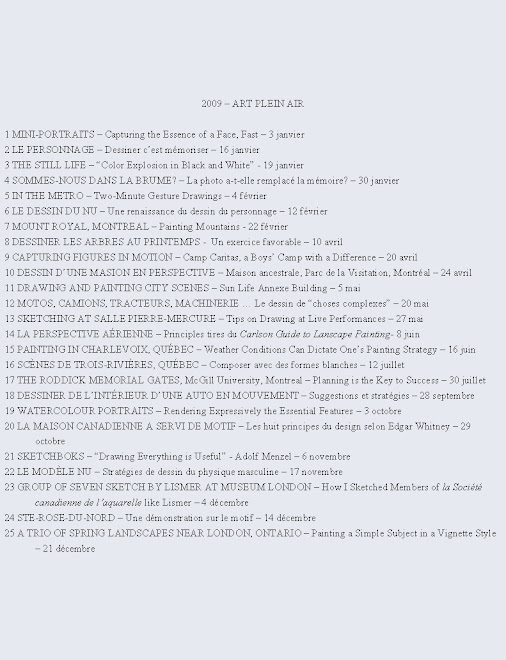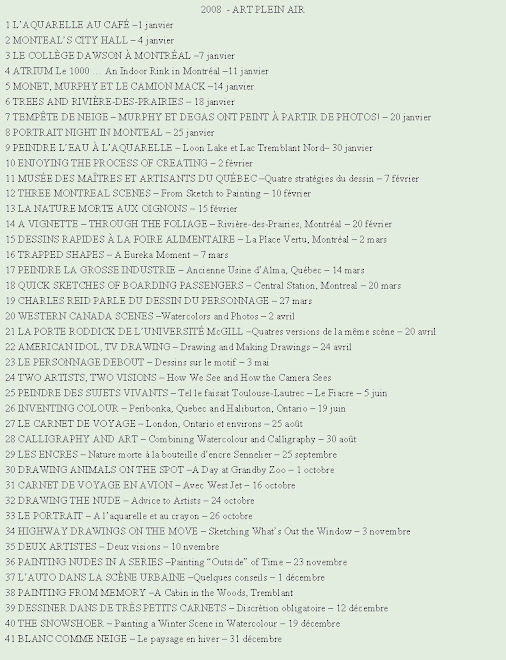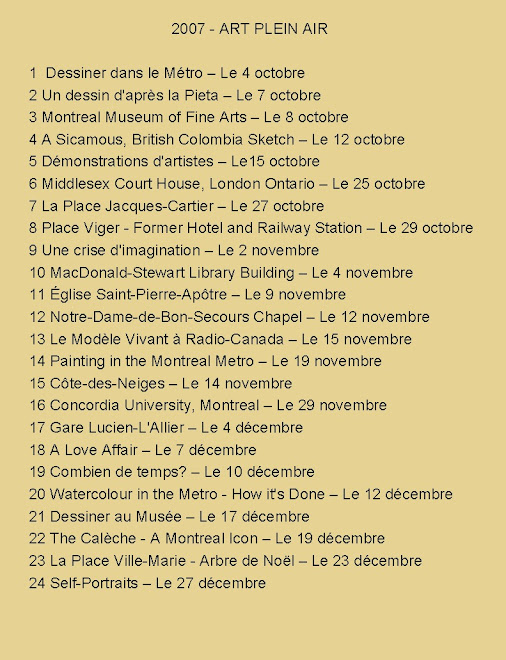Good sight lines make a difference
I was invited to paint at the 2011 annual Lyric Theatre Singers’ Christmas Concert. I had a clear view of the performers and musicians because I was reserved a seat. I painted two watercolors per show, one before the intermission and one after. Each took about 30-40 minutes.My Painting Setup
Usually I rest my corrugated plastic support board on my knees. I clip my paper to it. Sometimes, I attach the board on to a camera tripod. Then I slip a small round standard oil painter aluminum container (1/2 in diameter) onto a corner of the board. In the metal tray I insert a slightly smaller round plastic water container bought at the outdoor sports store La Cordée. I paint with two Kolinsky hair travel brushes. I use the smallest portable watercolor kit I own, the 8 color Windsor & Newton traveling kit found at Avenue des Arts on Victoria Ave. in Westmount. It has a convenient finger insert ring underneath and measures only 3 by 5 inches when opened. Holding this in my left hand along with a small paper towel I can support the 9 by 12 in. light plastic support with the same left hand.
Once the performers are on stage I spend two or three minutes observing and analyzing before putting a mark on my sheet. During this precious time I plan mentally the composition; where the main characters will be placed; the limits of the drawing and especially what I intend to include and to omit. I first draw the bones of the main performer and furniture. I will draw more precisely the contour of the foreground figures but I will only indicate the secondary ones with a summary line. The drawing takes about five minutes.
All the skin tones are put in first since these tend to be the lightest tones. While these heads, necks and arms are still partly humid I tint these further to indicate hair and shadow. I attempt to leave the figures further back diffused and less defined. I work much the same way with the clothing by adding lighter more diffused color to those in the background. The shapes, figures, instruments and furniture in the foreground are painted darker and hard edged. Background color is added next in a loose diffused manner stopping just short of the contour of the figures. I attempt to harmonize the background color with the remainder of the scene. When painting a complex scene often less is more. By this I mean that I try to limit my range of colors to a few complementary colors and a couple of cool colors.
A Note about the Lyric Singers
The Montreal based choral group has a long history. Other than performing its annual Christmas Concert at Ogilvy, the director Bob Bachelor leads the signers in stage performances in the spring and at other benefit concerts. In the spring of 2012 the troupe will put on the full Broadway show Curtains between May 31 and June 9. For more information visit their web site. Experience a wonderful evening of choral music by attending their next performance if you have not done so yet! And if you missed the Sing Noël Christmas Concert at Tudor Hall, you can attend the same show at the Rialto Théatre, 5723 ave. du Parc, Sunday December 11th at 2:00 pm.
Raynald Murphy sca
Note: Be sure to read Marilynn Vanderstaay's review about the Lyric Theratre Singers on
The Westmount Examiner's next publication.































































